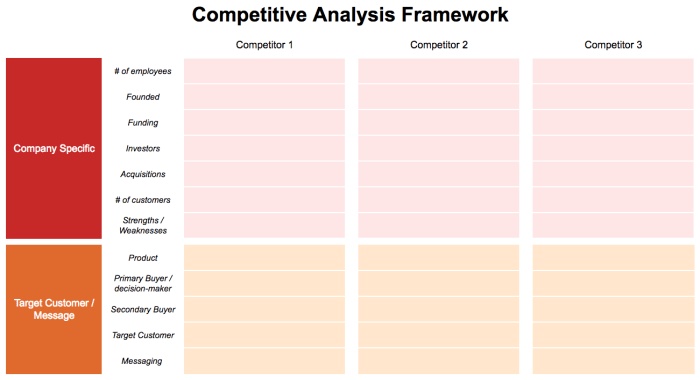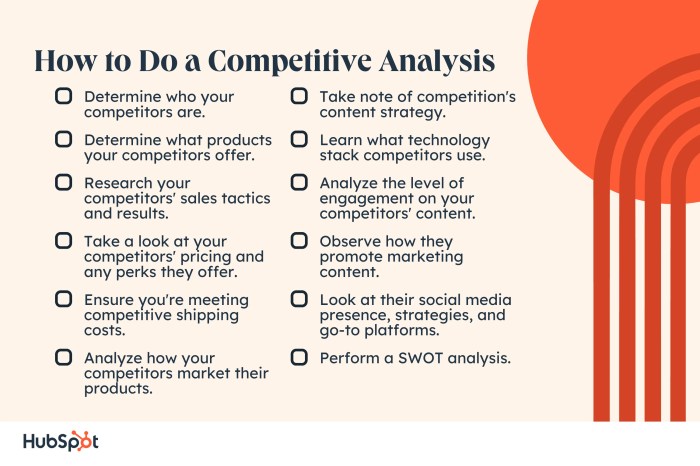Understanding Competitive Analysis is like having the ultimate playbook to dominate the market game. Get ready to uncover the secrets of successful companies and how they use competitive analysis to outsmart the competition.
From different analysis methods to essential tools, this guide will equip you with everything you need to level up your business strategy.
Why Competitive Analysis is Important: Understanding Competitive Analysis

Competitive analysis plays a crucial role in shaping a company’s business strategy by providing valuable insights into the market landscape and the actions of competitors. By understanding the strengths and weaknesses of rival companies, organizations can make more informed decisions to stay ahead in the market.
Significance of Competitive Analysis
Competitive analysis helps companies identify gaps in the market, anticipate competitor moves, and capitalize on emerging trends. By monitoring the competitive landscape, businesses can adjust their strategies to better position themselves for success.
- By analyzing competitors’ pricing strategies, companies can adjust their own pricing models to remain competitive while maximizing profits.
- Studying competitors’ marketing tactics can help companies differentiate their brand and attract a larger customer base.
- Understanding competitors’ product offerings allows companies to develop unique selling points and enhance their product portfolio.
Examples of Successful Companies
Several successful companies have leveraged competitive analysis to gain a competitive edge in the market:
Amazon
Amazon closely monitors its competitors’ pricing strategies and offers competitive prices while providing a wide range of products and services, dominating the e-commerce industry.
Apple
Apple conducts thorough competitive analysis to stay ahead in the tech industry, creating innovative products that set them apart from competitors and maintain a loyal customer base.
McDonald’s
McDonald’s continuously evaluates competitors’ menu offerings and customer preferences to introduce new menu items and promotions, staying relevant in the fast-food market.
Types of Competitive Analysis
Competitive analysis involves different methods to evaluate the competitive landscape and make informed business decisions. Let’s explore some of the key types of competitive analysis methods.
SWOT Analysis
SWOT analysis stands for Strengths, Weaknesses, Opportunities, and Threats. It helps businesses identify internal strengths and weaknesses, as well as external opportunities and threats in the market. By conducting a SWOT analysis, companies can assess their current position and develop strategies to leverage strengths and opportunities while mitigating weaknesses and threats.
Porter’s Five Forces Analysis
Porter’s Five Forces analysis is a framework developed by Michael Porter to analyze the competitive forces within an industry. It includes the threat of new entrants, bargaining power of suppliers, bargaining power of buyers, threat of substitute products or services, and rivalry among existing competitors. This analysis helps businesses understand the competitive dynamics in the industry and develop competitive strategies to stay ahead.
Comparison between SWOT Analysis and Porter’s Five Forces
While SWOT analysis focuses on internal factors and external market conditions, Porter’s Five Forces analysis specifically examines the competitive forces within an industry. SWOT analysis looks at the overall business environment, including strengths and weaknesses that are under the company’s control, while Porter’s Five Forces delves into the specific industry dynamics that impact competition.
Unique Insights provided by each type of Competitive Analysis
SWOT analysis provides a comprehensive view of the internal and external factors affecting a business, enabling companies to capitalize on strengths and opportunities, while addressing weaknesses and threats. On the other hand, Porter’s Five Forces analysis offers a more industry-focused perspective, helping businesses understand the competitive landscape, identify potential threats, and formulate strategic responses to enhance their competitive advantage.
Conducting Competitive Analysis
When it comes to conducting a competitive analysis, there are several steps involved to ensure a comprehensive understanding of the competitive landscape in your industry. By following these steps and gathering data effectively, you can stay ahead of the competition and make informed strategic decisions for your business.
Steps in Conducting Competitive Analysis, Understanding Competitive Analysis
- Identify Your Competitors: Start by identifying who your direct and indirect competitors are in the market.
- Analyze Competitor Strategies: Look into the strategies, strengths, weaknesses, and market positioning of each competitor.
- Gather Data: Collect data on competitors’ products, pricing, marketing tactics, distribution channels, and customer base.
- SWOT Analysis: Conduct a SWOT (Strengths, Weaknesses, Opportunities, Threats) analysis for each competitor to understand their competitive advantage.
- Identify Trends: Keep an eye on industry trends and changes that could impact your competitors’ performance.
Tips for Gathering Data Effectively
- Utilize Competitive Intelligence Tools: Invest in tools that can help automate data collection and analysis for more accurate insights.
- Monitor Social Media: Track your competitors’ social media activity to understand their engagement with customers and market trends.
- Attend Industry Events: Participate in industry events and conferences to network with competitors and gather valuable information.
- Surveys and Interviews: Conduct surveys or interviews with customers, suppliers, and industry experts to gain insights into your competitors.
Importance of Continuous Monitoring and Updating
- Market Dynamics: Markets are constantly evolving, so continuous monitoring helps you adapt to changes and stay competitive.
- New Competitors: New competitors can enter the market at any time, making it crucial to keep your analysis up to date.
- Performance Tracking: By monitoring your competitors regularly, you can track their performance and adjust your strategies accordingly.
Tools and Resources for Competitive Analysis

In the realm of competitive analysis, having the right tools and resources at your disposal can make a significant difference in gaining valuable insights and staying ahead of the curve.
Commonly Used Tools for Competitive Analysis
- Semrush: This tool provides in-depth data on competitors’ s, backlinks, and advertising strategies, helping you identify opportunities for improvement.
- Ahrefs: A powerful tool for analyzing backlinks, organic search traffic, and rankings of your competitors, enabling you to uncover their strategies.
- SpyFu: With SpyFu, you can spy on your competitors’ PPC campaigns, s, and ad copy, allowing you to refine your own advertising tactics.
- Google Alerts: Set up alerts for your competitors’ brand mentions, product launches, or industry news to stay informed about their activities.
Role of Market Research Reports and Industry Publications
Market research reports and industry publications play a crucial role in competitive analysis by providing comprehensive insights into market trends, consumer behavior, and competitor strategies. These resources can help you:
- Identify emerging trends and opportunities in your industry.
- Analyze the strengths and weaknesses of your competitors.
- Understand consumer preferences and market demands.
- Stay informed about new products, technologies, and innovations in the market.












